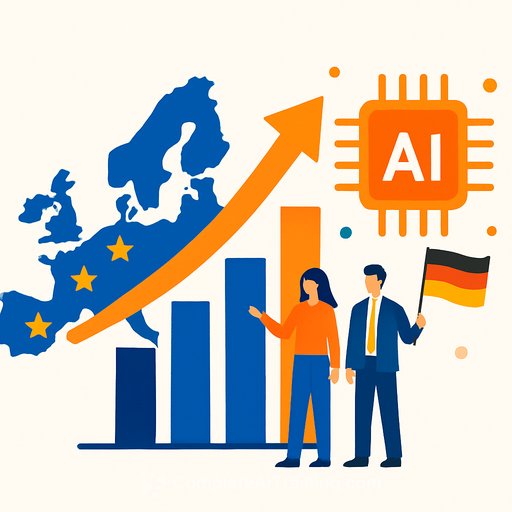Europe's Generative AI in the SDLC: What IT and Engineering Leaders Need to Know (2025-2032)
Generative AI across the software development lifecycle is set to grow at a 33.6% CAGR from 2025 to 2032. Germany led the region in 2024 with a 20.8% share and is on track to reach USD 225.6 million by 2032. The UK and France are catching up fast, with projected CAGRs of 32.4% and 34.7% respectively. In short: adoption is accelerating, and governance is the filter.
Governance-first Europe: the new baseline
The EU AI Act took effect on August 1, 2024 and-alongside NIS2, the Cyber Resilience Act, DORA, and the EU Data Act-sets clear rules for safe, risk-based AI in development workflows. Oversight from the European Commission's AI Office is pushing standardization and cross-border coordination, giving buyers clearer requirements and fewer surprises.
Where vendors are moving
Microsoft, OpenAI, Google, Atlassian, and JetBrains are aligning features to EU requirements. Expect integrated platforms that span code editors, repos, planning, CI/CD, and security-built around auditability, data residency, model oversight, and controlled autonomy. The shift is from helpers to agentic workflows with guardrails. Competition hinges on trust and distribution, not just model quality.
Application outlook
- Code Generation & Auto-Completion
- Personalized Development Tools
- Natural Language Interfaces for Development
- AI-Enhanced Design and UX
- Other Application
In the UK, Code Generation & Auto-Completion reached USD 8.6 million in 2024 and is projected to grow at 31.5% CAGR through 2032. Natural Language Interfaces for Development are set for a 33.2% CAGR over the same period.
Country outlook: Germany sets the bar
Germany is doubling down on sovereignty and enterprise-grade coding agents. The EU AI Act's phased requirements starting August 2025, plus BSI guidance on bias, security, and transparency, are formalizing risk management, traceability, and model oversight across pipelines. Amazon Q Developer, GitHub Enterprise Cloud, and JetBrains are rolling out EU-compliant options, including local inference.
Flagship rollouts at SAP and Hapag-Lloyd show how productivity and governance can co-exist. Differentiation comes from auditability, data residency, and tight fit with German toolchains. Meanwhile, the UK and France are growing fast, with CAGRs of 32.4% and 34.7% respectively.
Who adopts and why
- Software Engineers/DevOps: faster code generation, backlog triage, CI/CD automation, and incident resolution.
- Security/SecOps: threat detection, vulnerability analysis, code scanning, policy enforcement, and automated reporting.
Practical playbook for engineering and platform teams
- Adopt governance-by-design: model cards, dataset traceability, prompt logging, and audit trails as defaults.
- Select platforms with EU data residency, private networking, and granular data retention controls.
- Enforce secrets hygiene: block sensitive tokens in prompts; add pre-commit and pipeline checks.
- Use policy-aware agents with clear scopes: repo whitelists, least-privilege credentials, and human-in-the-loop for merges.
- Integrate with CI/CD: signed artifacts, SBOM generation, automated changelog and test synthesis, and policy gates.
- Build a red-teaming loop for prompts and agents; simulate jailbreaks and data exfiltration scenarios.
- Prefer local or regional inference for sensitive code; use retrieval isolation and per-tenant vector stores.
- Measure with lagging and leading indicators: PR lead time, escaped defects, MTTR, prompt-to-merge conversion, and security findings per KLOC.
- Budget for observability: prompts, responses, model versions, and decision traces stored for audit.
- Create a vendor checklist: data processing addendum, model lineage, eval benchmarks, and exportable logs.
Key companies covered
- Microsoft Corporation
- OpenAI, LLC
- NVIDIA Corporation
- Google LLC
- Anthropic PBC
- Amazon Web Services, Inc. (Amazon.com, Inc.)
- Meta Platforms, Inc.
- IBM Corporation
- Accenture PLC
- Adobe, Inc.
Market segmentation
- By End-user
Software Engineers/DevOps Professionals; Security Professionals/SecOps - By Application
Code Generation & Auto-Completion; Personalized Development Tools; Natural Language Interfaces for Development; AI-Enhanced Design and UX; Other Application - By Country
Germany; UK; France; Russia; Spain; Italy; Rest of Europe
Next steps
Shortlist platforms that can prove EU compliance, integrate with your toolchain, and ship with clear audit paths. Pilot in one domain (e.g., code review or CI/CD) with measurable targets, then scale by policy and pattern, not ad hoc plugins.
Need a fast scan of coding-focused tools? Try this curated list: Generative AI tools for coding.
Your membership also unlocks:






